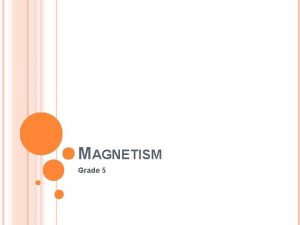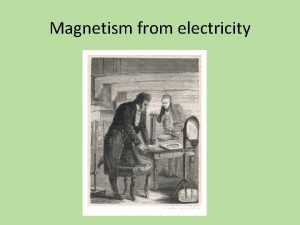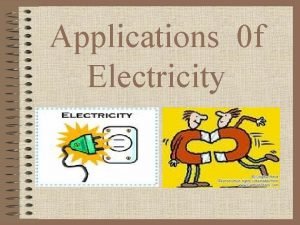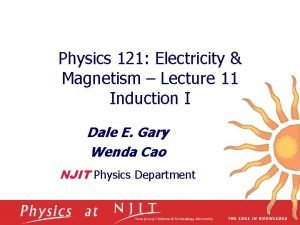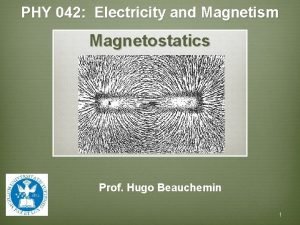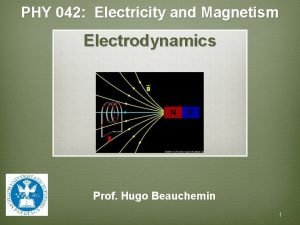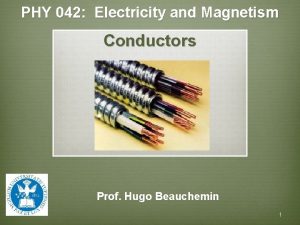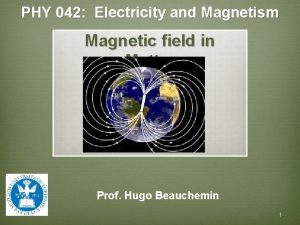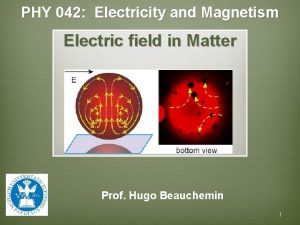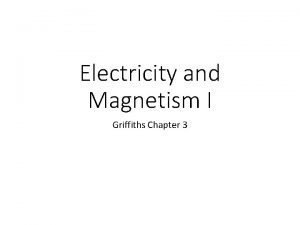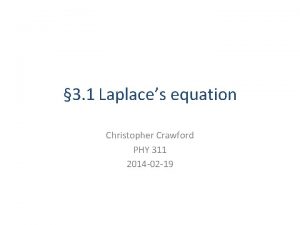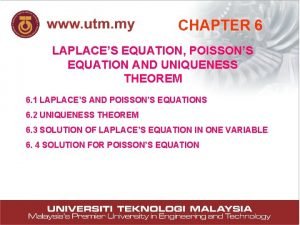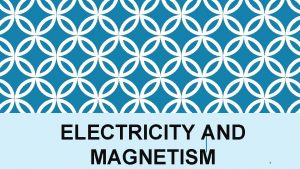PHY 042 Electricity and Magnetism Laplaces equation Prof













- Slides: 13

PHY 042: Electricity and Magnetism Laplace’s equation Prof. Hugo Beauchemin 1

Introduction I v Typical problem in E&M: A set of conductors are maintained at a given potential to shape a field outside the conductors in order to perform some task. We need to know what is the field created. v Example: drift chambers v Knowing the electric field allows to compute drift time, and therefore to determine particle trajectories in the detector (tracks) 2

Introduction II v In the previous example: we don’t know the charge distribution nor the total charge, but we know the voltage on the conductors because they are maintained by hand We can find the E-field everywhere using Laplace’s equation v A potential that doesn’t fully satisfy Laplace’s equation together with a certain set of boundary conditions in a region of space where there is no charge is not an electrostatics potential v To fully appreciate the gain in generality provided by the Gauss’ equation (+ Helmholtz’ theorem) in its differential form, the development of more in-depth mathematical tools to solve the Laplace’s equation is needed v The techniques apply equally well to Quantum and Newtonian mechanics, astronomy, fluid mechanics, heat theory 3

A 1 D intuition v To get an intuition about solving the Laplace’s equation, let study the 1 D case Two undetermined constants Ø Using the boundary conditions specified in a concrete experiment (problem), we can solve for m and b and get a unique solution Ø v E. g. : {V(0), V(L)}, {V(0), V’(0)}, {V(0), V’(L)}, etc. v The solution has two simple but important properties: 1. v Solution satisfied the superposition principle v Similar to stationary wave solutions … 2. The solution has no max nor min, except at the end points 4

Higher dimensions v Laplace’s equation now becomes a partial differential equation v The general solution is not expressible with just 2 arbitrary constants v It generally needs an finite number of free constants v There are no simple general solution: case by case v The two properties in 1 D are generalizable to higher dimensions v The value of V at r is the average of V over a spherical surface of radius R centered on r v This is used to get numerical solutions to Laplace’s equation v V cannot have any local min nor max, except at boundaries v Will use these two properties to show that: A set of boundary conditions suffices to uniquely find V from Poisson/Laplace 5

How to solve Laplace? v Once again, there is no general solution to the equation and the number of constants to be fixed completely depends on the boundary conditions and thus on the problem to be solved v But there are many different methods that can be used to solve different classes of problems, classes that each account for many different experimental setups and contexts. v There are problems that are formally and mathematically related to each others such that the same techniques of solving Laplace can be used for all of them. v Problems (situations, setups) where V or s is specified on the boundary and V must be determined inside the interior: Solve by a method called: separation of variables v Still very general: this corresponds to many concrete devices such as drift chamber detectors where an E-field is produced 6

Types of boundary conditions v The separation of variables method applies when either V or s is specified on the boundary. Means two very different things 1. Empirically: Two very different experimental preparations: v Fixing V means grounding a conductor or attaching it to a battery v Fixing s means charging a conductor, and maintaining the charge distribution constant 2. Mathematically: two different formalisms for fixing V or s: v V=V 0 solution is known at some x 0 Dirichlet conditions v s=s 0 derivative of solution is known at x 0 Neumann conditions v For conductors, just need to know Qtot (theorem) With a complete set of Dirichlet and/or Neumann conditions the solution to Laplace’s equation is unique 7

A generic example Problem: y Two infinite grounded metal plates parallel to the XZ plane at y=0 and y=a, and an infinite strip insulated from the two plates situated at x=0 and maintained at a fixed potential V 0(y) V=0 V=V 0(y) V=0 x Find V between plates z Solution 1. Find boundary conditions 2. Apply separation of variables 3. Get general solutions to each 4. Apply boundary conditions to fix separated diff. eqn. free constants 8

A generic solution v Solving the Laplace’s equation with the method of separation of variables for the above 2 D problem yields the general solution: v Use boundary conditions specific to this problem to fix A, B, C, D, k v After having applied 3 of the boundary conditions, we are left with a family of solutions to Laplace’s equation with these boundaries v The sum of solutions is a solution to Laplace’s equation, with different boundary conditions v Remember V 3 in our proof of uniqueness v Fourier series provide THE solution to our generic problem 9

Another generic example: spherical symmetry I v Laplace’s equation takes a different form: v Assume again separation of variables (with azimuthal symmetry): v An eigenvalue problem Remember spherical harmonics v l is an integer number v Remember quantization of angular momentum v Solution for Q(q): Legendre’s polynomial 10

Spherical symmetry II v Solution to R(r): v guesses from limiting cases: and v If this is a solution, then this is the solution… v From this intuitive approach, we have as a general solution: v We then need specific boundary conditions to fix Al, Bl 11

Example: hollow sphere v An hollow sphere of radius R is maintained at a potential V 0(q) on its external surface v Boundary conditions Inside Outside V(0, q)<∞ V(∞, q)<∞ V(R, q)=V 0(q) v Generally, the potential V 0 applied to the V 0=ksin 2 q/2 sphere is not a Legendre’s polynomial, but any functions decided by the experimenter ⇒ Need to use Fourier again v Assume V 0(q) = ksin 2(q/2) 12

Another example v Grounded hollow sphere in an constant external electric field: v The solution is: v First term: external field contribution E=E 0 z v Second term: contribution due to the induced charge v The induced charge is: v Positive at the top, negative at the bottom 13
 Physics 102 electricity and magnetism
Physics 102 electricity and magnetism Ib physics electricity and magnetism
Ib physics electricity and magnetism Electricity and magnetism lecture notes
Electricity and magnetism lecture notes Electricity and magnetism jeopardy
Electricity and magnetism jeopardy Sph3u electricity and magnetism
Sph3u electricity and magnetism Relationship between electricity and magnetism
Relationship between electricity and magnetism Induced magnetic moment
Induced magnetic moment Electricity and magnetism grade 5
Electricity and magnetism grade 5 Electricity and magnetism
Electricity and magnetism Electricity and magnetism
Electricity and magnetism Ampere
Ampere Electricity and magnetism
Electricity and magnetism Electricity and magnetism
Electricity and magnetism How are static electricity and current electricity alike
How are static electricity and current electricity alike







